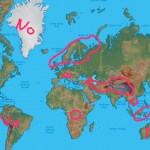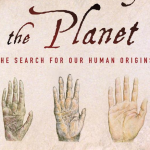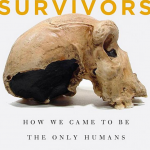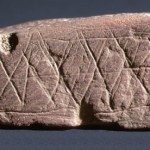Origin of Modern Humans
Years ago I proposed a theory (not anywhere in print, just in seminars and talks) that went roughly like this. Humans hunt. Dogs hunt. Prey animals get hunted. Each species (or set of species) has a number of characteristics such as the ability to stalk, track, kill, run away, form herds, etc. Now imagine a landscape with humans, wolves, and game animals all carrying out these behaviors, facilitated with various physical traits. Then, go back to the drawing board and redesign the system.
The hunting abilities of humans and dogs, the tendency of game animals to herd up or take other…
Nature editor and author Henry Gee has produced his Christmas list in which he describes his three wishes as an editor at a scientific journal; he enumerates the scientific discoveries that sit at the top of his professional "bucket list."
Henry Gee. Not a Leprechaun.
I started to write a comment on Henry's blog post, here, but it turned into a blog post of my own, here:
Henry: As you know, I address in a fictional context in "Search for Sungudogo" (now only 99 cents on Amazon) all three of your wishes, the discovery of life elsewhere in the universe, the discovery of intelligent life…
Yesterday I wrote about Chris Stringer's modified version of human evolution. Today, let's have a look at Ian Tattersall's new book, Masters of the Planet: The Search for Our Human Origins (Macsci). Tatersall's boo, like Sringer's, is a good overview of the newer evidence in the constantly changing field, but he goes back earlier and provides a much broader context for human evolution. His main thesis is that the features that made modern humans unique have two main characteristics: 1) they were sufficient and causal in the process of making that one species "master of the planet" and 2)…
Chris Stringer's new book, Lone Survivors: How We Came to Be the Only Humans on Earth, attempts to reconcile the age-old conflict between the "Multiregional" and "Out of Africa" hypotheses of Modern Human origins. Stringer has long been identified with the "Out of Africa" hypothesis, and his criticism of the Multiregional model pretty much still hold. In the Multiregional model, different groups of a human ancestor, i.e., Homo erectus (and friends) existed over a large region of the earth (Africa and Eurasia) and different populations of that ancestral populations evolved in parallel to…
Check out this video my friend Lynn made:
More here, including lots of text. Teachers, you could probably find a use for this in your classroom.
My interest is in developing a plausible evidence-based story of how modern humans emerged from ancestral species. This means guessing at what features of humans make us "human" and attempting to see the emergence of each of these features in the fossilized record of our bodies (bones) and behaviors (artifacts and archaeological sites). This question has traditionally been treated, inappropriately, as simple. Walking upright, or freeing of the hands, or using tools, or hunting animals, or scavenging from carnivores, violence, provisioning mates, bonobo-ism (a form of erotica, it would seem…
This post has moved HERE. To the stone age blog!
From Skeptically Speaking:
We talk to author Christopher Ryan about his new book Sex at Dawn: The Prehistoric Origins of Modern Sexuality. We'll discuss the most recent science and theories, and how social norms compare to our biological impulses.
This Friday. Details here. I may have to read this book.
The first part of this documentary, including the preface and the first several minutes of the main body of the work, should be deleted. The writers and producers who put that part together should be captured, gutted, eviscerated, and their dried and salted remains staked to the front entrance of the Public Broadcasting System as a reminder for other writers and producers. Why? Here's why:
What was said was pure teleology. At some point, sixty million years ago, the path that human evolution would follow was set. Some of the ancestral forms stayed on the path to us, others did not and…
Sometimes people walk around with only half a brain, or a large portion of their brain disconnected, or simply having never developed, or an extra large brain, and we usually take little notice. But when there is a five or ten or twenty percent difference between two groups of people we are quickly willing to use that to decide (as in the Bell Curve) that those people with the (on average) smaller brain are inferior. The fact that all the well known studies comparing groups of living people that show such differences have been shown to be bogus (i.e. made up or doctored data) is often…
The Aquatic Ape Theory is being discussed over at Pharyngula. As PZ points out, an excellent resource on this idea is Moore's site on the topic. Here, I just want to make a few remarks about it.
The Aquatic Ape Theory (AAT) is a human evolution Theory of Everything (TOE) and thus explains, as it should, everything. That is a dangerous way for a theory to act, because if it tries to explain everything then it is going to be wrong in a number of places, and it is going to seem (or even be) right in a number of places but only by chance. (Unless, of course, the TOE is totally rad and really…
What was Neanderthal-Modern Human interaction really like? Fifty four teeth (some of which are fragments) and nine other bones dating to about 40-43,000 years ago represent the "most recent, and largest, sample of southern Iberian late Neanderthals currently known."
These and some closely related remains may indicate that these Middle Paleolithic holdouts were kissing cousins of nearby anatomically modern humans. Or maybe not.
We know that Neanderthals occupied all of Europe for over 125 thousand years during a period known (from the artifacts) as the "Middle Paleolithic." During…
Allen's Rule. One of those things you learn in graduate school along with Bergmann's Rule and Cope's Rule. It is all about body size. Cope's Rule ... which is a rule of thumb and not an absolute ... says that over time the species in a given lineage tend to be larger and larger. Bergmann's Rule says that mammals get larger in colder environments. Allen's Rule has mammals getting rounder in colder climates, by decreasing length of appendages such as limbs, tails and ears.
All three rules seem to be exemplified in human evolution. Modern humans tend to be larger and rounder in cooler…
One of the most important evolutionary transitions in human prehistory was the rise of modern humans (Homo sapiens) from earlier hominids. A newly reported fossil from Tanzania provides an important new data point necessary to understand this transition.
Homo erectus/ergaster probably gave rise to Homo sapiens (modern humans) somewhere in Africa. It is very likely that earlier hominids (H. erectus/ergaster) and later hominids (some sort of archaic H. sapiens) co-existed, and it is also the case that during this transitional period there would be individuals with either a mixture of traits…
It almost seems like there are two separate research project under way regarding the evolutionary history of Homo sapiens. One focuses on recent humans, tends to use DNA as a major source of information, and from this base projects back into the past. This approach tends to confirm the idea that humans share an African origin with a subsequent spread from Africa, with various degrees of complexity in that series of historical events. The other focuses on early human remains, sometimes including remains that would be placed by some in a separate species or sub species. This sort of…
Evolution: The Mind's Big Bang
I've known Shea for years ... since before grad school. Going out drinking with this guy was a little dangerous. Almost as dangerous as going out drinking with me.
Last night, the Campus Atheists, Skeptics and Humanists club (C.A.S.H.) presented a debate between PZ Myers and Loyal Rue on the question: Can religion and science co-exist? I witnessed this event and would like to tell you what happened.
I want to begin with a message to PZ Myers: Thank you, PZ, for your service! There are a lot of people in the twin cities who could engage in an interesting debate on religion, atheism, evolution, creationism, etc. and do an OK job, but none others have the experience and intellectual preparation (to do an excellent job) and the draw (to guarantee lots…

Did humans wipe out the Pleistocene megafauna? This is a question that can be asked separately for each area of the world colonized by Homo sapiens. It is also a question that engenders sometimes heated debate. A new paper coming out in the Journal of Human Evolution concludes that many Pleistocene megafauna managed to go extinct by themselves, but that humans were not entirely uninvolved.
The paper by Pushkina and Raia ("Human influence on distribution and extinctions of the late Pleistocene Eurasian megafauna") examines sources in the literature and a number of databases for Eurasian…
Pumice is rock that is ejected from a volcano, and has so much gas trapped in it that it can float. So when a pumice-ejecting volcano (not all volcanoes produce pumice) goes off near a body of water, you can get a raft of rock floating around for quite some time. By and by, water replaces the gas within the rock and it sinks. Like a rock. So, you can get layers of pumice on the bed of lakes, seas and oceans. A forthcoming paper in Deep Sea Research I describes two such pumice deposits of "Drift Pumice" in the Indian Ocean.
The fact that the two deposits are more or less on the surface of…
Homo floresiensis more widely known as the "Hobbit," may have had arms that were very different from those of modern humans.
A paper in the current issue of the Journal of Human Evolution explores the anatomy of H. floresiensis. To explore this we first have to understand the concept of "Humeral torsion." Humeral torsion is the orientation of the humeral head relative to the mediolateral axis of the distal articular surface. Don't bother reading that sentence again, I'll explain it.
The humerus is the upper arm bone, that runs between your shoulder and your elbow. The humeral head is…




